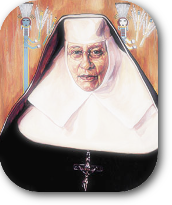Dear Brothers and Sisters,
 May the Lord bless you! In honor of the 750th Anniversary of the death of St. Clare, our Sister, Sr. Claire Andre, OSC, wrote an article celebrating St. Clare, which was published in St. Anthony Messenger Press. It is rather lengthy, but gives us further insight into the life of St. Clare – her strength, her leadership, her ability to totally trust in the providence of God. As Sr. Claire Andre points out, the life and example of St. Clare remain relevant for us today. Consider what relevance her example holds for you and how, through her intercession, you can be drawn closer to the Lord. Here’s the first installment – more to follow in August.
May the Lord bless you! In honor of the 750th Anniversary of the death of St. Clare, our Sister, Sr. Claire Andre, OSC, wrote an article celebrating St. Clare, which was published in St. Anthony Messenger Press. It is rather lengthy, but gives us further insight into the life of St. Clare – her strength, her leadership, her ability to totally trust in the providence of God. As Sr. Claire Andre points out, the life and example of St. Clare remain relevant for us today. Consider what relevance her example holds for you and how, through her intercession, you can be drawn closer to the Lord. Here’s the first installment – more to follow in August.
Peace and good,
Rosie
Celebrating St. Clare of Assisi, by Sister Claire Andre Gagliardi, OSC
Within each of us is the potential to be a light focusing attention on God’s presence in our world. Clare of Assisi’s life reveals just how much light she shed.
As a friend and as cofounder of the Franciscan movement, she supported Francis as he discerned God’s message for himself and his followers. Together with her sisters, she wrote the first Rule written for religious women by a woman. She modeled the ability for the authority or power of a group to be held by the entire group (collegiality).
This year, the Franciscan family throughout the world celebrates the 750th anniversary of Clare’s death in August 1253. Her life continues to speak to all of us. She challenges us to incorporate simplicity, singleness of purpose and unity within families and communities into the complexity of our 21st-century lives.
Clare was born in 1193 in Assisi, a small town in the scenic Umbrian Valley of Italy. She was born of nobility, the oldest child of Ortulana and Favarone di Offreduccio.
At the end of the 12th and the beginning of the 13th century, Italy was a cauldron of political and military strife. Society was divided into two groups: the maiores and minores. The maiores were the nobility. The minores were former serfs, who had become merchants, craftsmen and field workers. These two groups were continually fighting for power among themselves.
In her early youth, Clare was exiled to Perugia. While the men in the family were off fighting their wars, the women chose to live as penitents. Ortulana, along with her daughters, as well as other women among Clare’s family and friends, were fasting, praying, bringing food to the poor and visiting prisoners.
This time of suffering and exile became a time of spiritual formation. Many of the women living with Clare in Perugia, including her mother and sisters, later became some of Clare’s first followers in San Damiano.
In 1205, Clare’s family returned to Assisi. Francis had already begun his conversion. He had publicly renounced his father and started rebuilding San Damiano. In 1208, he began preaching. Clare’s cousin Rufino became one of his early followers.
Clare’s household had to have experienced the stir that Francis was causing. An eyewitness, cited in the Acts of the Process of Canonization [of Clare], said that, during this time, Clare went to hear Francis preach, gave him some money to rebuild churches and to feed the poor, and arranged to talk to him in private.
Clare and Francis were both experiencing God breaking into their lives, changing them and calling them to give themselves over to God. Both were facing unknowns and both were probably frightened and unsure of themselves. It must have been a comforting grace to meet a kindred spirit and to encounter another human being who was experiencing the same call and facing the same doubts.
Clare’s sister Beatrice tells us (in the document of the canonization process) that Francis first initiated the visit with Clare. Some speculation suggests that women were asking to join his movement and Francis needed a strong woman to lead the others.
Clare’s reputation for holiness was well known in Assisi. She would be the perfect leader. Who went to whom first is unimportant. The important reality was that God had a plan and that Francis and Clare were open to being led.
Francis and the brothers received Clare on Palm Sunday night at the chapel of St. Mary of the Angels (the Portiuncula) in the year 1212. Shortly after this, she was taken to San Paolo, a Benedictine monastery in Bastia.
The men in Clare’s family were not happy with her following Francis. Their power and wealth were diminishing with the changes in society. Clare was beautiful and they had hoped that her marriage would bring prestige and continued wealth into the family. They followed her to San Paolo with every intention of bringing her home.
Clare instead held on to the altar and claimed sanctuary. She had made her choice. She would never turn back.
Clare’s sister Catherine, soon to be called Agnes, joined Clare. The two lived for a while with a group of Beguines (13th-century women under vows) in Sant’Angelo in Panzo until Francis brought them to the church of San Damiano. There, the Lord gave them sisters and their community grew quickly.
Clare’s community was to be vastly different from the monastic communities of her time. The sisters were to live poorly without large land holdings. Like Francis, their Rule would be to embrace the gospel form of life. They would all be of equal rank, and all decisions affecting their life would be made by all of them.
They would have an abbess, but she would consider herself “the servant of the sisters” and she would lead more by her example of virtue than by instruction or admonition.
Clare was the perfect follower of Francis. She understood his message and would spend her entire life making it a lived reality. Her life and the lives of the early sisters, however, were not easy ones.
Francis died young. Clare outlived him by 27 years. She remained firm and kept the ideal alive, despite Francis’ absence and the dissension among his brothers. The Church would see the poverty of her life as too difficult. She negotiated with popes and worked to get her Rule approved until the day before she died—August 10, 1253.
Most of her life, Clare lived with sickness. While she complained little of her own illness, she is known for frequently healing others. She lived an enclosed life within the narrow confines of a small monastery in Assisi. Yet her story is known around the entire world today.
